Whole house water filters are expensive investments. You’ll often end up spending at least $1,000 on the system itself – and that doesn’t include the extra costs of equipment for maintenance, or hiring a professional plumber to install the system for you.
We don’t blame you if you’re considering making your own whole house water filter system. As long as you’re the handy type and you’re prepared to put in the hard work, you can save a whole lot of money by doing it yourself.
In this guide, we’ve shared everything you need to know about taking on this DIY project, including the materials and tools you’ll need, the steps involved, and the perks of making your own whole house water filter.
Note: This guide covers how to make your own whole house filter system from separate filter cartridges supplied by manufacturers. We don’t recommend making your own filter media. It’s too difficult, time-consuming, and unreliable for whole-house filtration.
Table of Contents
🧰 Why Make Your Own Whole House Water Filtration System?
There are plenty of reasons to consider making a DIY whole house filter system:
- You can choose exactly what your filter contains. If you prefer certain filtration media, or you’re targeting a specific set of contaminants, you can choose the filter that best suits your needs.
- You’ll know exactly what materials and components are included in your system, so maintenance, troubleshooting, and filter replacements should all be easy.
- You’ll save hundreds of dollars that you’d otherwise spend on a pre-fabricated system. Plus, you’ll save money when you start using the filter full-time rather than getting through hundreds of water bottles a year.
- You don’t need many materials or tools. You probably already own the tools you’ll need for this DIY project, and the plumbing supplies required for the job can be found at most hardware stores.
- You can make any modifications you want throughout the lifespan of your system.
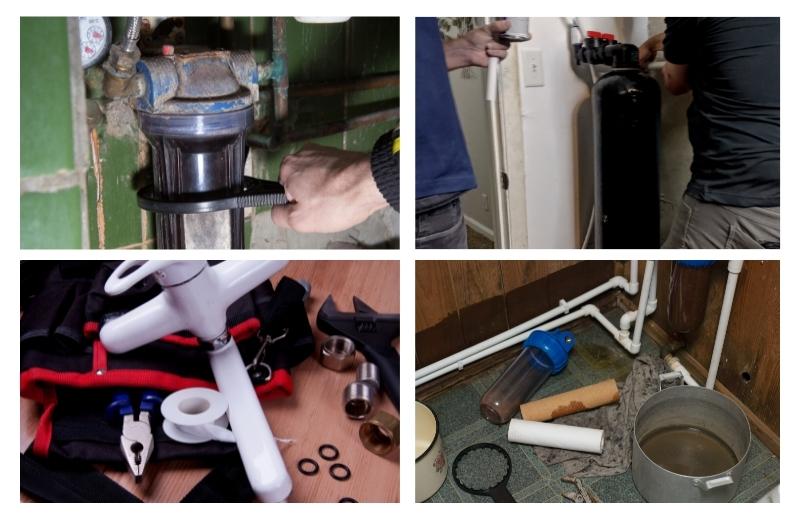
❌ Setbacks of Making your Own Drinking Water Filter System
Of course, there are a few setbacks to consider when deciding whether to make your own whole house filter:
- It takes time. This isn’t a project you can complete in a couple of hours. You’ll need a lot of patience, and you’ll probably end up making more than one trip to your local hardware store.
- The quality can’t be guaranteed. Even if you think you’ve done everything right, your system might end up leaking or simply not working.
- You’ll need to do this job yourself. It’s highly unlikely that a plumber will feel comfortable installing your DIY project on your behalf.
- You don’t know for certain that the filter is working. The only thing you can do is get your water tested, which can be expensive.
📖 How to Make a Whole House Water Filtration System: Step-by-Step
Keen to learn how to make a whole house water filter system yourself? Follow these steps.
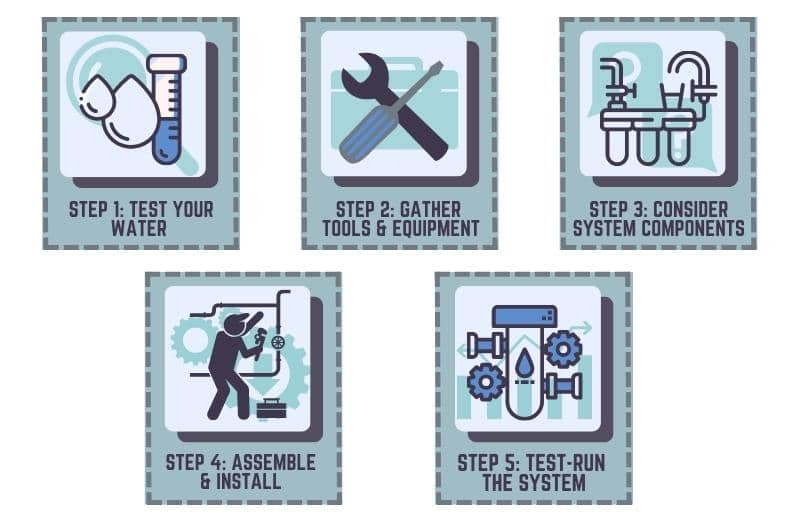
Step 1: Get your Water Tested
Before you get started, the first step is to test your water. You won’t know what filter types to include in your system if you don’t know what you need to remove, after all.
If you’re trying to spend as little money as possible, buy a test kit for the most common water parameters. These are widely available online and cost less than $20.
If you want to know exactly what your water contains, look into private laboratory testing. SimpleLab Tap Score is our recommended laboratory for testing city water, and offers an Essential City Water Test for just under $140. You can also find well water tests on the website.

Remember that city water and well water contain a different selection of contaminants and will likely influence the types of filter media you put in your water filtration system. While chlorine and chloramine are the biggest city water issues, well water usually contains sediment, hardness minerals, iron, and manganese.
Related:
- Top POE Well Water Filtration Systems (2024 Reviews)
- How to make a DIY well water filter
Step 2: Gather your Materials
Once you know what you want to remove from your water, make a list of these contaminants and set it aside. You now need to gather all the tools and materials you’ll need for the job.
We’ve shared an example list of the equipment you’ll need below, but you may need additional supplies depending on the nature of your whole house filter system.
Commonly-needed supplies include:
- Drill and drill bits of various sizes
- Pipe cutter/hacksaw
- Adjustable wrench
- Teflon tape
- Bucket
- Screwdriver
- Tubing
- Shut-off valves
- Connectors, such as elbows, tees, and push fittings
Optional supplies include:
- Mounting bracket
- Pressure gauges
- Bypass valves
- Solder supplies
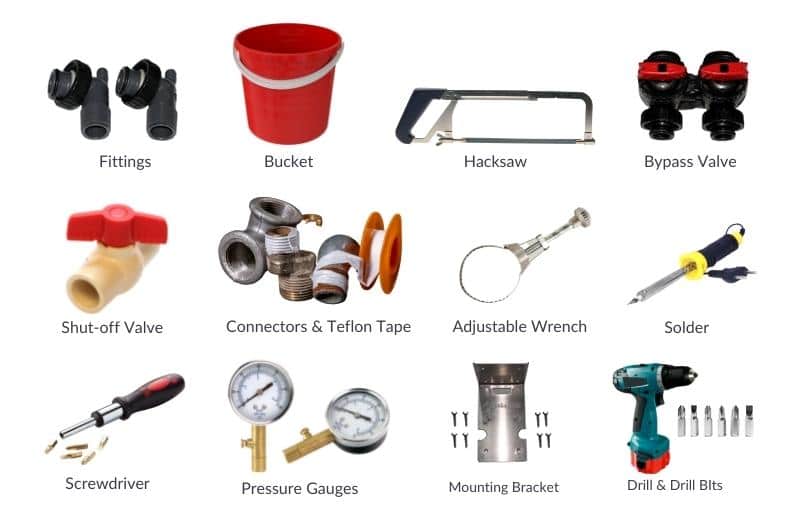
Step 3: Consider the System Components
Next, you need to consider which components you want to include in your water filtration system.
Water Filters
Start with the most important component of any whole house water filter: the filter cartridges.
You’ll need to research the different whole house water filter cartridges available, then choose filter housing that can accommodate these filters (most housing is designed to fit 1-3 filters).
Look for industry-sized filters, not proprietary filters, to ensure they’ll fit in your housing. Look at filter housings that accommodate 10-inch or 20-inch filters with diameters of 2.5 or 4.5 inches.
The bigger the filter size, the faster the flow rate. That doesn’t mean that you have to go for the largest filter you can find, though. A 20-inch filter with a 2.5-inch diameter has an average flow rate of 8-10 gallons per minute, which is ideal for a home with 1-3 bathrooms.
What are the benefits of choosing individual filter cartridges for your water filtration system? You’ll be able to choose specific cartridges for targeting difficult-to-remove contaminants, like filters specialized in removing arsenic or nitrate. You can also save a lot of money by buying individual cartridges from unknown brands versus buying filtration systems containing virtually the same cartridges from well-known brands.
The types and quantity of filters you choose are up to you, but we recommend buying filters that are tested to NSF Standards so that you know they’ll work.
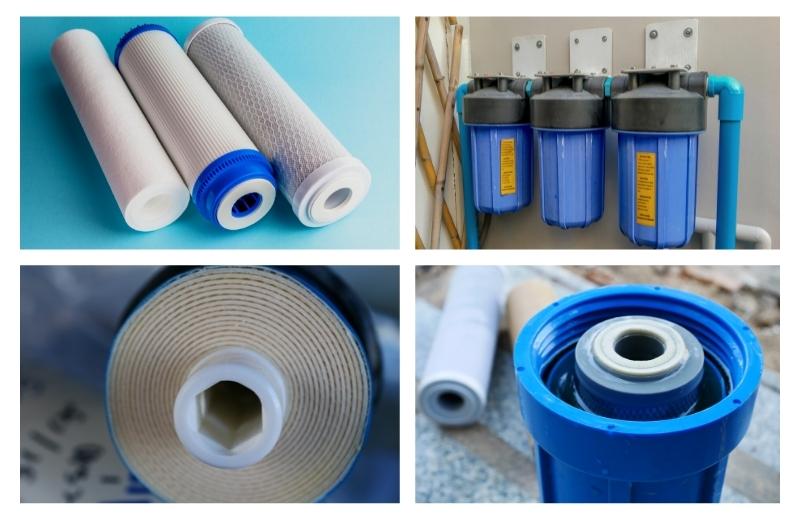
Filter Type
Let’s look in more detail at the types of filters you should choose for your water filtration system.
- Sediment Filters: These filters are the first stage in most commercially-available whole home water filter systems. They’re designed to protect the later filter stages from large particulates that could clog the media and reduce its lifespan.
- Granular Activated Carbon Filters: These are the most common whole house water filter type, removing contaminants affecting taste and smell, like chlorine. They’re usually 5 microns in size.
- Carbon Block Filters: These are compressed activated carbon. They’re more thorough than granular activated carbon filtration, but they also reduce flow rate, so we don’t recommend them as a top choice for whole house systems.
- Catalytic Carbon Filters: These filters are designed to remove chloramine – something that regular activated carbon can’t do. They also reduce VOCs and THMs.
- Iron & Manganese Filters: These are designed to remove iron and manganese, so they’re a good choice to consider if you have well water.
- KDF, Activated Alumina, & Ion Exchange Filters: These filters are either dedicated filters or blended with another filter media, like carbon, to remove specific contaminants, like fluoride, arsenic, and nitrate.
What should you know about filter micron rating? The higher the micron rating, the larger the filter’s pores, and the larger the contaminants a filter will trap. It’s best to start with a filter with a high micron rating and gradually decrease the micron rating with each subsequent filter stage.
Pressure Gauges
Pressure gauges are an optional component in your DIY whole house water filter system.
Installing pressure gauges before and after each filter stage will take the guesswork out of replacing the filters. Each pressure gauge will give you a reading of the water pressure in each stage of the system. When the water pressure drops significantly, you know it’s time to replace a filter.
Bypass and Shutoff Valves
At the very least, we recommend installing a shutoff valve before and after your water filtration system. This will enable you to shut off the water flowing from your water supply line into the system. It’s handy if you need to do maintenance, and essential if your system springs a leak.
Bypass valves go one step further. They don’t only shut off the water supply into your filtration system; they also divert water through a separate water supply line around the system. This means you still get access to unfiltered drinking water while your system is out of use.
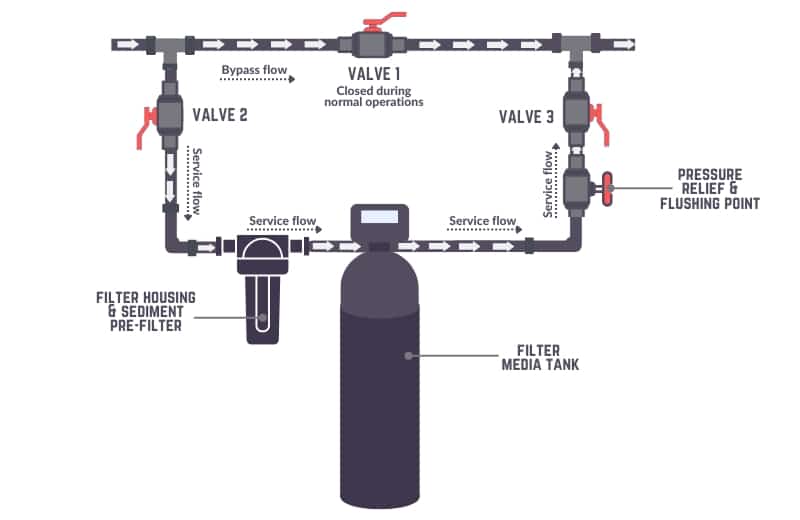
Drain Connection
If you plan to install a more complex system that performs backwashing cycles, you’ll need a drain connection.
Drain connections are an easy way to transport contaminant-laced water out of a filter, preventing it from clogging quickly. You can connect a drain line to a sediment filter to extend its lifespan.
To enable the filter to clean itself automatically, you’ll need to install a timer-based valve that will open once a day, allowing the sediment to leave.
Step 4: Assemble and Install the System
Once you’ve bought everything you need, the final job is to assemble and install the system at your main water supply line.
This should be fairly easy if you’re good at DIY projects. You’ll just need to place the filter cartridges inside the housing and connect the housing up to your own plumbing supply.
You won’t have specific instructions to follow, as you would if you purchased a pre-fabricated system from a manufacturer. This means you’ll need to follow more generalized instructions and use your own initiative. Our guide on how to install a whole house water filter should prove useful.
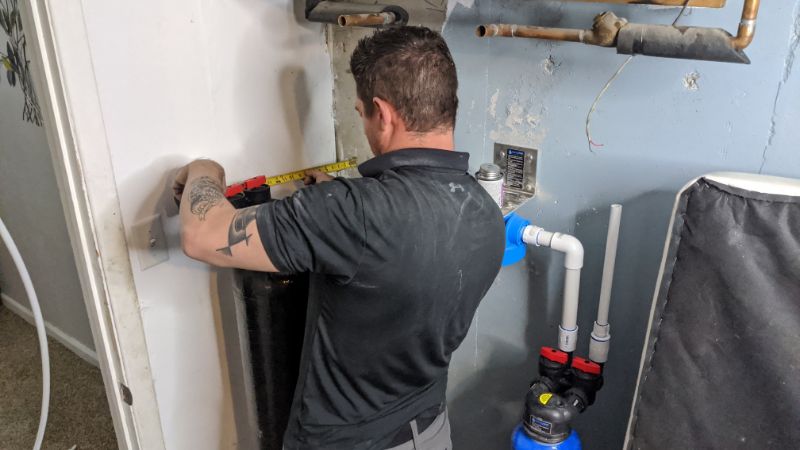
Here are several important things to keep in mind when you’re installing your tap water filter system:
- Before you get started, make sure that your installation process complies with your state’s plumbing codes. You don’t want your hard work and effort to be for nothing.
- If you’re planning to install your filter system outside, it’ll need adequate protection. Build a cupboard around the filter to protect it from the sun, rain, and frost.
- Think carefully about the location that you install your filter. The general rule is to install it as close to water’s entry into your home as possible, upstream of your hot water heater. This means that your entire home will be supplied with filtered water.
- Consider installing a separate pre-filter if you haven’t included a sediment pre-filter in your system. This will protect the filter stages from abrasive contaminants.
- Don’t overtighten plastic fittings or use a metal wrench. Instead, hand-tighten them, and use plumber’s tape to seal your fittings and connections, preventing leaks.
- Make sure the o-rings are lubricated and sit correctly in the system.
Additionally there are plenty of videos on YouTube that can help you through the process:
Step 5: Test-Run the System
When you’ve completed the installation, give the system a final check and make sure everything looks and feels right. Turn on your water supply and check the system for leaks.
If you notice leaking from any part of the filter, turn off your water supply and tighten the fitting, or create a better seal with Teflon tape.
You can now test the quality of your drinking water. Take a sample of your tap water and test it using the same method of testing that you used originally. Compare your original test results to your new results. Hopefully, you should now have filtered water.

🧠 DIY Water Filter FAQs
How much does it cost to make your own water filter system?
The cost of making your own water filter system is about $500, depending on the supplies and equipment you buy. This is at least half the cost of buying a complete filter system from a manufacturer online.
Is it possible to make your own water softener?
No. Water softener systems aren’t customizable like water filter systems. If you removed or swapped out any of the components, the system wouldn’t work.
What’s the cheapest way to make your own water filter system?
The cheapest way to make your own water filter system is to buy separate filters and filter housing and install the system at your water line.
Note that there are other DIY filters that you can make for emergency situations, but these aren’t suitable for installing at your point of entry for filtering the water supply in your entire home. Simply boiling your water is the most affordable way to produce safe, clean water for drinking in emergencies.
What are the best filters to put in a DIY filtration system?
This depends on what you want to remove from your water. If you want to eliminate common city water impurities, like chlorine and heavy metals, your main types of filter media should be carbon and KDF. For well water filtration, consider sediment and iron filters.
Related: Read about the Different Whole House Water Filter Types here
Can a homemade water filtration system remove bacteria from my water?
Rarely. You’d have to look at filters with small enough media to trap bacteria. This would greatly reduce your water pressure, and you likely wouldn’t be able to deliver enough water around your home. If you want to achieve pure water with whole house filtration, consider adding a UV lamp to your unit.
📑 Takeaway: Should You Make Your Own DIY Water Filter System?
It takes a lot of time and effort to make your own whole house water filtration system, and you need to get everything absolutely right if you want the filter to be both safe and effective.
Remember, you’re installing this system at your waterline, so you need to be certain that it won’t cause a catastrophic leak in your home. The quality of your DIY water filter needs to be excellent.
If you doubt your DIY skills or you just don’t have the time or energy to make your own whole house filtration system, buying a pre-made system is your best option. You might pay more to buy from a manufacturer, but you’ll know for certain that the system is built to last, with durable components. Many manufacturers only use certified parts and have third-party test results to prove that their product is capable of reducing certain contaminants.
Ultimately, the choice is yours. There are pros and cons to making your own DIY filter, just as there are pros and cons to buying a filter from a manufacturer. Commit to one option, and make sure you’re prepared – whether that’s mentally or financially!
